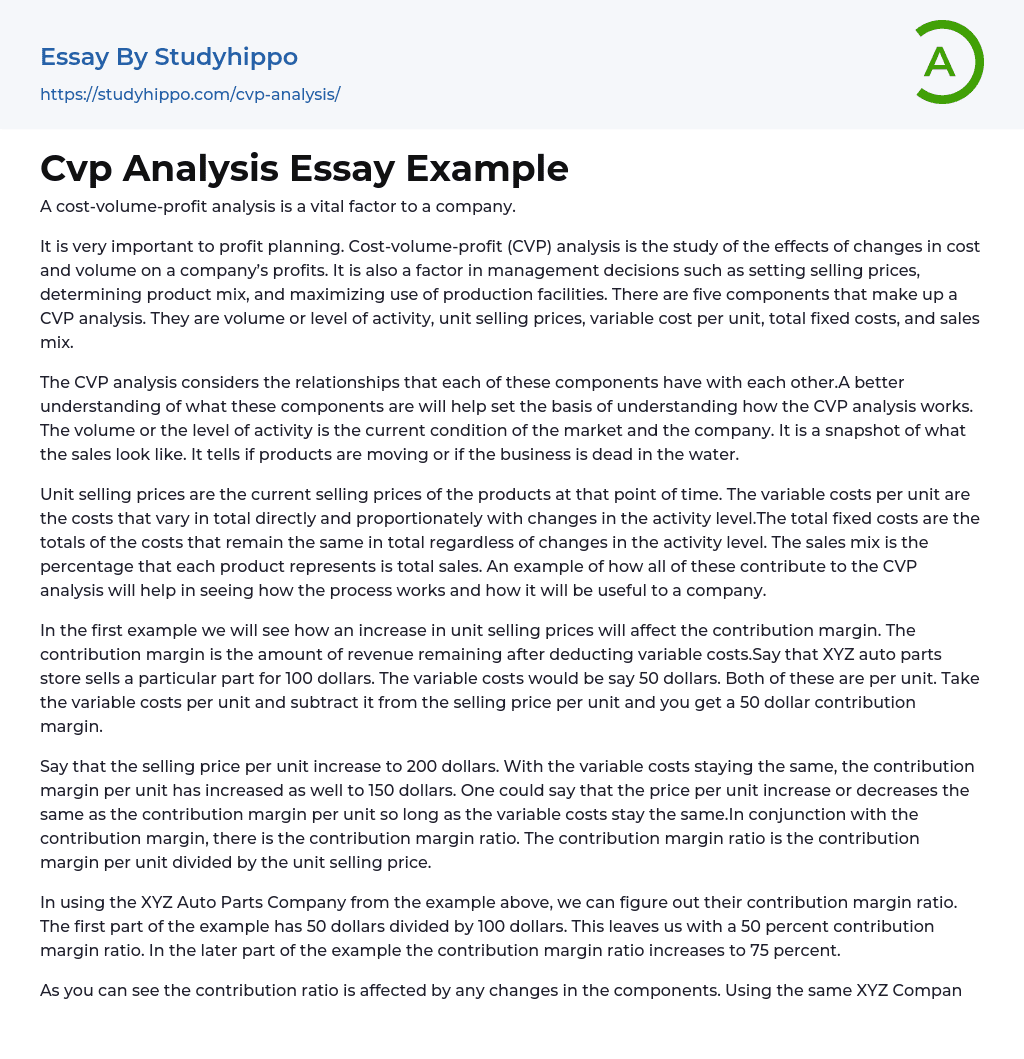A cost-volume-profit analysis is a vital factor to a company.
It is very important to profit planning. Cost-volume-profit (CVP) analysis is the study of the effects of changes in cost and volume on a company’s profits. It is also a factor in management decisions such as setting selling prices, determining product mix, and maximizing use of production facilities. There are five components that make up a CVP analysis. They are volume or level of activity, unit selling prices, variable cost per unit, total fixed costs, and sales mix.
The CVP analysis considers the relationships that each of these components have with each other.A better understanding of what these components are will help set the basis of understanding how the CVP analysis works. The volume or the level of act
...ivity is the current condition of the market and the company. It is a snapshot of what the sales look like. It tells if products are moving or if the business is dead in the water.
Unit selling prices are the current selling prices of the products at that point of time. The variable costs per unit are the costs that vary in total directly and proportionately with changes in the activity level.The total fixed costs are the totals of the costs that remain the same in total regardless of changes in the activity level. The sales mix is the percentage that each product represents is total sales. An example of how all of these contribute to the CVP analysis will help in seeing how the process works and how it will be useful to a company.
In the first example we will see how an increas
in unit selling prices will affect the contribution margin. The contribution margin is the amount of revenue remaining after deducting variable costs.Say that XYZ auto parts store sells a particular part for 100 dollars. The variable costs would be say 50 dollars. Both of these are per unit. Take the variable costs per unit and subtract it from the selling price per unit and you get a 50 dollar contribution margin.
Say that the selling price per unit increase to 200 dollars. With the variable costs staying the same, the contribution margin per unit has increased as well to 150 dollars. One could say that the price per unit increase or decreases the same as the contribution margin per unit so long as the variable costs stay the same.In conjunction with the contribution margin, there is the contribution margin ratio. The contribution margin ratio is the contribution margin per unit divided by the unit selling price.
In using the XYZ Auto Parts Company from the example above, we can figure out their contribution margin ratio. The first part of the example has 50 dollars divided by 100 dollars. This leaves us with a 50 percent contribution margin ratio. In the later part of the example the contribution margin ratio increases to 75 percent.
As you can see the contribution ratio is affected by any changes in the components. Using the same XYZ Company, we can see what affect a decrease in fixed costs will have on sales. Using the formula from the school’s material, sales equals variable costs plus fixed costs plus net income. If the variable costs and the net income stay the same and
only the fixed costs would decrease, the sale would then also decrease. This is only taking into account that the other two variables of the formula stay the same, which in real life it is a possibility that they would change.
- Auction essays
- Balanced Scorecard essays
- Business Plans essays
- Expense essays
- Income essays
- Net Income essays
- Security Guard essays
- Singapore Airlines essays
- Battle essays
- Intranet essays
- Maintenance essays
- Simulation essays
- Inn essays
- Net Present Value essays
- Income Statement essays
- Leadership and Management essays
- Change Management essays
- Project Management essays
- Knowledge Management essays
- Operations Management essays
- Quality Management essays
- Risk Management essays
- Scientific Management essays
- supply chain management essays
- Performance Management essays
- Time Management essays
- Brand Management essays
- Total Quality Management essays
- Risk essays
- Manager essays
- Leadership essays
- Business Ethics essays
- Board Of Directors essays
- Product Management essays
- Comparative Analysis essays
- Decision Making essays
- Dispute Resolution essays
- Stress Management essays
- Business Management essays
- Brand Equity essays
- Branding essays
- Nike, Inc. essays
- Market share essays
- Razor essays
- Being A Leader essays
- Servant Leadership essays
- Leadership Experience essays
- Leadership Qualities essays
- Incentive essays
- Advertising essays




